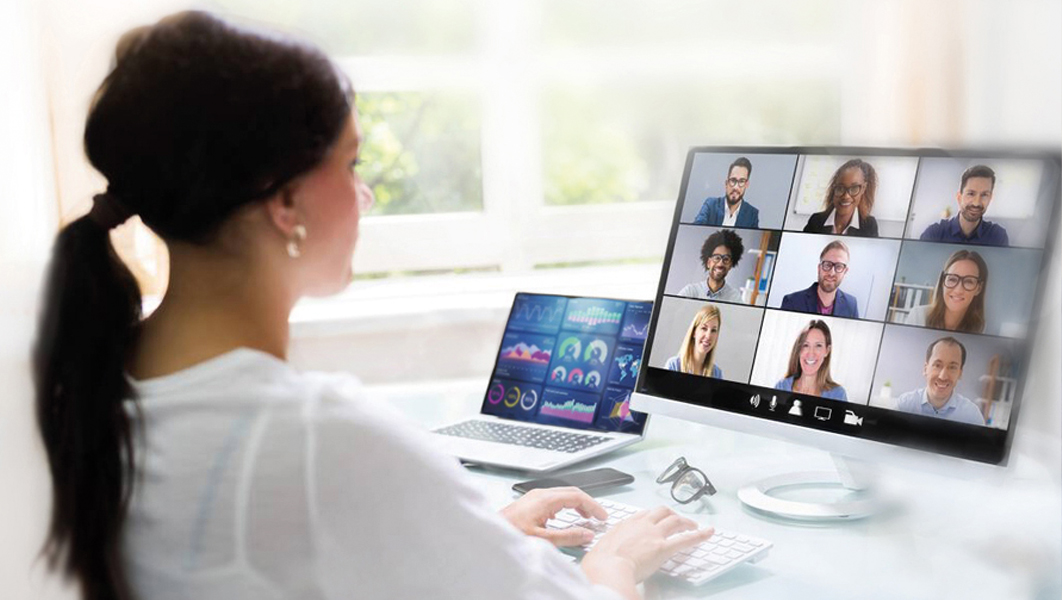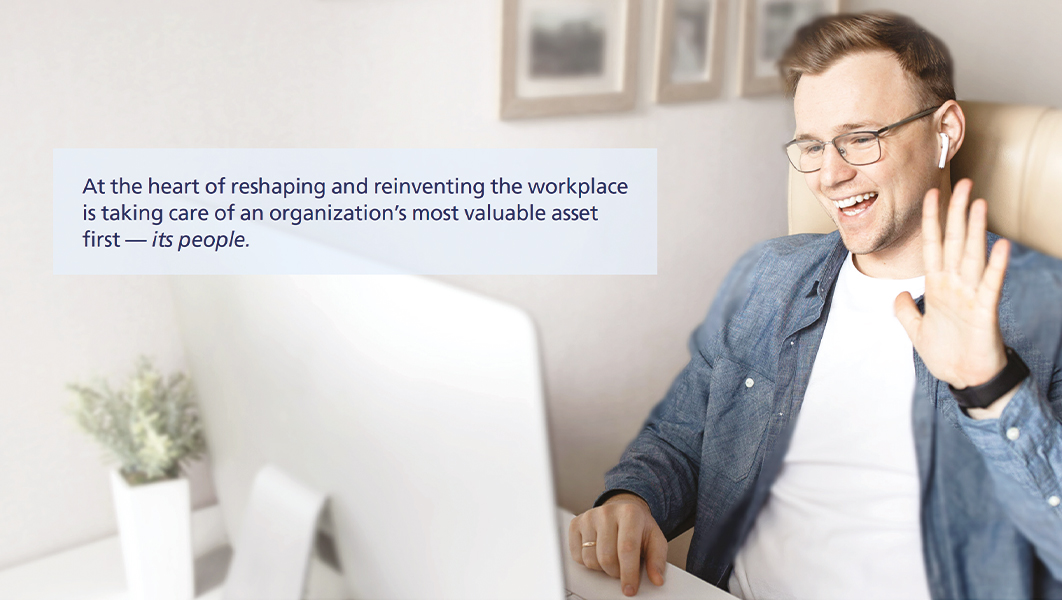Future of Work
THE FUTURE OF WORK
The future of work mindset: Building more agility, flexibility and resilience in your organization
The economic, social and healthcare shockwaves caused by COVID-19 have disrupted businesses and lives around the world. The lasting impacts are still to be determined, but one thing we do know is that the crisis has accelerated workforce trends that were already underway, such as remote working, technology-enabled training and teams collaborating based on functional expertise rather than geographical location.
Out of the abrupt changes forced on them by the pandemic, leaders have the opportunity to design the future of work for their employees that can result in a more sustainable and resilient business model. This journey will require a new mindset, one that includes more open ways of interacting and collaborating to overcome the challenges and uncertainties employees may face for some time.
“It starts with listening and collaborating, with respect for different perspectives,” says Laura Rock, Chief Human Resources Officer for Zurich North America. “Listening with an open mind builds trust and gives everyone the confidence to air unique points of view. And that opens up a world of possibilities in problem-solving, innovation, decision-making and service.”
In the near-term, the transition to remote working and the need to incorporate social distancing measures are causing some challenges, especially for businesses like auto dealerships that have traditionally relied on face-to-face customer interactions and with employees who have not worked from home in the past. Recent research from the Society for Human Resource Management found that 71% of employers are struggling to adjust to remote work, and 65% say maintaining employee morale has been a challenge. The same article reported that more than one-third are facing difficulties with company culture.1


RESILIENCE STARTS WITH EMPLOYEE WELL-BEING
A focus on the physical and mental well-being of employees is now front and center as the reality of long-term remote working is becoming more certain. As businesses begin to bring employees back to work into a facility, or for essential workers who never stopped working in a facility, the assurance of physical security is now critical in creating a trusting bond between employer and employee.
One of the silver linings of this reentry and recovery period is that leaders have a historic opportunity to strengthen and deepen overall connections with their workforce by addressing feelings that were previously not part of the cultural conversation. Acknowledging the natural human emotions around additional responsibilities, remote working, and juggling personal and work commitments will result in a healthier organization, greater productivity and talent retention in both the near-term and the long run.
Today’s leaders and managers now have more mental, emotional and physical issues to handle with employees. To do so, organizations may want to make healthcare providers and mental health professionals available to the workforce.
FOSTER ORGANIZATIONAL AGILITY TO WEATHER FUTURE CHANGE
2020 will go down as a time of unprecedented and forced change in how we work, live and communicate. Virtually no one saw how fast the entire world would be required to adapt, but organizations and people have demonstrated they can adopt more agile ways when lives and livelihood depend on it.
A 2019 Gartner organization design survey found that 55% of organizational redesigns were focused on increasing efficiencies.2 This approach, however, also created vulnerabilities, as systems engineered solely for efficiency resulted in little flexibility to respond to disruptions. To help build resilience for future disruptions, organizations need to formalize how systems and processes can flex when necessary.
For business leaders, the COVID-19 era sheds light on the speed at which their organizations can move away from traditional processes, and how to scale workplace innovation in a short period of time. New York Times columnist Thomas Friedman believes that humans who want to adapt in an age of acceleration must develop “dynamic stability.” Although none of us can stop an inevitable storm of change, Friedman encourages leaders to “build an eye that moves with the storm, draws energy from it, but creates a platform of dynamic stability within it.”3
EMPOWER EMPLOYEE FLEXIBILITY IN SKILLS AND SCHEDULES
Prior to the pandemic’s outbreak, the World Economic Forum put forth the concept of cognitive flexibility as one of the top skills needed to excel in a workplace in 2020.4 What is cognitive flexibility, and what does that mean for an employee, much less for the managers and leaders of an organization? One way to think about cognitive flexibility is having the ability to shift mindsets, behaviors and perspectives to adapt to fast-moving situations and profound changes.
Nurturing employees to acquire more cognitive flexibility and adapt to new roles during rapids times of change requires providing cross-functional knowledge and training. “We believe in the power of curiosity and continuous learning,” Zurich’s Rock says. “Versatility and the ability to learn, quickly and constantly, are likely to become the most sought-after professional traits.”
Organizations that create an environment of continuous learning will be better positioned for a future of work where employees are always upskilling and reskilling to meet new challenges as they emerge.
Despite returns to the physical workplace, dealer workforce concerns remain unsettled. The retail automotive industry, like most every other, contemplates reopen strategies, worker and customer safety, and resource planning to account for volatility in public safety and policy amidst an ongoing pandemic.
“There’s no question that the dealership world has been transformed by the challenges of 2020. During this past spring and summer, many dealerships made hard decisions to close, scale back and reassess their true needs. Top dealerships will see this as an opportunity to invest in their teams and systems to ensure they can do more business with fewer, better dealership employees to still provide outstanding customer experiences, both in the showroom as well as the fixed-ops department.” 6
THE FUTURE OF WORK MINDSET: PEOPLE + PLACE
To future-proof your workforce and build a more resilient organization, meaningful change is required in both the teams of people you develop and the workplaces that you cultivate.

A resilient workforce is one that has the right skills and experience to achieve its purpose. To attract and engage a flexible workforce, many types of workers are needed and will likely come from disparate geographic locations. Organizations should create a culture of continuous learning to support the skill development necessary in leadership and technology to enable productive teamwork.

Employees are likely to be most productive and satisfied when offered a blend of physical and remote work environments. It’s critical that organizations invest in tools and platforms to support multiple work locations and seamless collaboration. Open and respectful communications between employer and employees are key to addressing needs.
EMBEDDING RESILIENCE TO HANDLE FUTURE UNCERTAINTY
Organizations have been thrust into an accelerated timeline for determining what the future of work will look like. So far, integrating technology and encouraging different employees to collaborate in new ways is resulting in better, faster and even cost-effective ways of operating for many organizations. We know from history that moments of crisis can only be survived through quick, decisive actions by an organization’s leaders. Ensuring the ability to weather tomorrow’s unknown changes, however, requires organizations to create mindfully a sustainable future of work — one that embeds resilience by building agility and flexibility into every process and with each employee.
People matter. Put them first.
Employees who feel heard, safe and productive are integral to the success of an organization, regardless of the external events impacting the work and the workforce. Here are a few tips leaders can use to show up and be there for people every day:
- Set the tone at the top. How leaders behave defines the culture. Neither overreacting to nor underplaying, an event is helpful. Proactive, consistent communications give your people confidence and direction for today and the future.
- Think of your whole workforce. Your workforce is not just employees, but also partners and vendors. Be sure they are included in conversations and decisions, and set expectations for flexibility and agility from them as well.
- Commit to a communication strategy. Your workforce needs accurate and authoritative information, as well as transparency. Front-line managers are critical to sharing information, so be sure they know their roles and expectations.
- Establish employee support methods. Times of challenge and uncertainty create questions, anxiety and stress. Be sure your employees have an outlet to express their voice.
- Alonso, Alexander. “Viewpoint: Here’s What the Future of Work Will Look Like.” Society for Human Resource Management. Accessed 17 July 2020. https://www.shrm.org/
- Cheremond, RJ. “9 Future of Work Trends Post-COVID-19.” Gartner, Inc. 8 June 2020. https://www.gartner.com/
- St. Louis, Zach. “Thomas Friedman on Human Interaction in the Digital Age.” The Aspen Institute. 10 January 2017. https://www.aspeninstitute.org/
- Ahmed, Waqas. This Is the Indispensable Skill That Will Futureproof Your Career.” Fast Company. 16 June 2020. https://www.fastcompany.com/
- Cheremond, RJ. “9 Future of Work Trends Post-COVID-19.” Gartner, Inc. 8 June 2020. https://www.gartner.com/work
- Hireology. The 2020 State of Hiring, Retail Automotive Hiring Trends.
7 DEALER PRINCIPAL